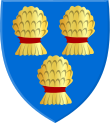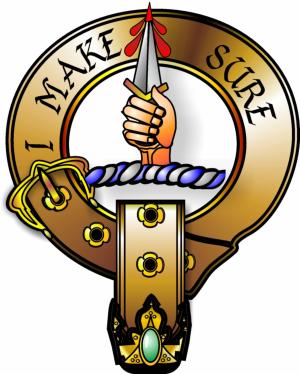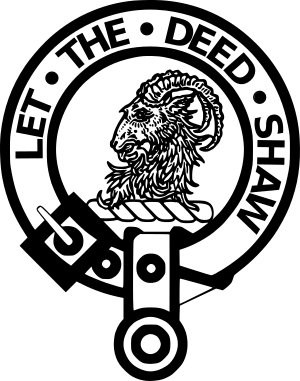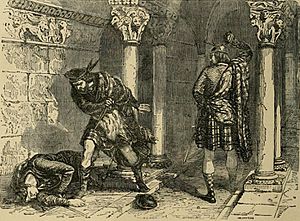John Comyn III of Badenoch facts for kids
Quick facts for kids
John Comyn
|
|
|---|---|
 |
|
| Born | c. 1274 |
| Died | 10 February 1306 Greyfriars, Dumfries, Scotland
|
| Cause of death | Stabbing |
| Other names | Red Comyn |
| Years active | 1296–1306 |
| Office | Guardian of Scotland |
| Spouse(s) | Joan de Valence |
| Children | John Comyn IV Elizabeth, Baroness Talbot Joan, Countess of Atholl |
| Parent(s) | John Comyn II Eleanor Balliol |
| Relatives | King John Balliol (uncle) John Comyn, Earl of Buchan (cousin) |
| Family | Clan Comyn of Badenoch |
| Guardian of Scotland | |
| In office 1298–1304 Serving with
|
|
| Preceded by | William Wallace |
| Succeeded by | John of Brittany (appointed by Edward I of England) |
| Military service | |
| Battles/wars | Scottish Independence War • Battle of Dunbar (1296) • Battle of Roslin (1303) Edward I's Flemish campaign |
John Comyn III of Badenoch, also known as the Red Comyn (born around 1274 – died February 10, 1306), was a powerful Scottish noble. He played a very important part in the First War of Scottish Independence. This was a time when Scotland fought for its freedom from England.
John Comyn served as a Guardian of Scotland. This was like being a temporary ruler after his uncle, King John Balliol, gave up his throne in 1296. For a while, John Comyn led Scotland's defense against attacks from England. He was killed by Robert the Bruce in a church in Dumfries. This happened because some believed Comyn had a stronger claim to be the next King of Scotland than Robert.
His father, John Comyn II (called the Black Comyn), was one of the people who wanted to be King of Scotland. His mother was Eleanor Balliol, who was King John Balliol's sister. John Comyn III also had ties to the English royal family. In the early 1290s, he married Joan de Valence, a cousin of King Edward I.
Contents
The Comyn Family's Power
The Comyns were one of the most powerful families in Scotland before the Wars of Scottish Independence began. They owned a lot of land in both the north and south of the country. They also had a lot of political power and family connections to the Scottish crown. This family first came to Scotland during the time of King David I.
In the 1200s, they gained control of the area called Badenoch. They also owned large parts of Lochaber and the earldom of Buchan. When King Alexander III died, John Comyn's father was chosen as one of the Guardians. Their job was to wait for the young Margaret, Maid of Norway, who was Alexander III's granddaughter, to arrive and become queen.
However, Margaret died in 1290. This caused a big problem for Scotland. The issue was finally solved in 1292 when John Balliol became king. The Comyn family supported King John. However, another important person, Robert Bruce of Annandale (who was the grandfather of the future King Robert the Bruce), never accepted this decision. The Comyns and William Wallace both supported King John.
Comyn in the War
When war started between England and Scotland, John Comyn, his father, and his cousin, John Comyn, Earl of Buchan, attacked Carlisle. This town was defended for King Edward by Robert Bruce, Earl of Carrick, who was the father of the future king. So, the Wars of Scottish Independence began with a fight between the Bruces and the Comyns.
Since they didn't have equipment to attack a castle, the Comyns left Carlisle. They then joined the main Scottish army near Haddington. This army had gathered to stop the English army advancing along the east coast. On April 27, the Scots were badly defeated at the Battle of Dunbar. John Comyn was among the many Scots taken prisoner. While his father and cousin went north with King John, John Comyn III was sent south to be held in the Tower of London.
John stayed in prison for several months. But since the war in Scotland seemed to be over, he was finally set free. The condition was that he had to serve King Edward in Flanders (modern-day Belgium). This was where Edward was fighting a war against the French. While there, John learned about the Scottish uprisings led by William Wallace and Andrew Moray. He also heard about their victory over the English at the Battle of Stirling Bridge. In March 1298, John was among the Scots who left the English army. He eventually ended up in Paris, France, where he asked King Philip IV of France for help for Scotland. The only help they got was a ship back to Scotland, arriving before the summer.
Battle of Falkirk
Earlier that year, William Wallace became Guardian of Scotland after Andrew Moray died. The main job for Wallace was to gather a national army to face an invasion by King Edward. Edward wanted to get revenge for the Scottish victory at Stirling Bridge. For cavalry (soldiers on horseback), which was the weakest part of the Scottish army, Wallace relied on the Comyns and other noble families.
On July 22, Wallace's army was destroyed at the Battle of Falkirk. The Scottish light cavalry was quickly driven away by the strong English cavalry. It is possible that John Comyn was at this battle, but we don't have clear proof. The main Scottish historical writings, by John Fordun and John Barbour, were written many years after the battle. By then, the Comyn family had been forced out of Scotland. These writers also wanted to make the later King, Robert the Bruce, look good and make John Comyn look bad.
According to Fordun, John Comyn and his family hated Wallace. He claimed they only appeared on the battlefield to betray him. He wrote that they "forsook the field, and escaped unhurt." Fordun also praised Robert the Bruce, saying he fought with the English and helped them win. However, this is questioned because no Bruce is listed on the Falkirk roll of nobles in the English army. Soon after the defeat, John Comyn and Robert the Bruce were named as joint Guardians of Scotland, replacing Wallace.
Guardian of Scotland
William Wallace, whose power came from his army's success, either resigned or was removed as Guardian after the defeat at Falkirk. In his place, John Comyn and Robert the Bruce became joint Guardians. This was a difficult situation because the Scots were still fighting for the absent King John Balliol. Bruce must have pretended to support this cause, even though everyone knew he wanted to be king himself.
At a meeting of nobles in Peebles in August 1299, an argument happened about Wallace's property. Wallace was in France at the time. It is said that Comyn grabbed Bruce by the throat during this argument. William Lamberton, the Bishop of St. Andrews, was then appointed as a third Guardian. Lamberton was a friend of both Wallace and Bruce.
Bruce resigned before May 1300, as it looked more and more like King John Balliol would return. This left only Comyn and Lamberton as Guardians. When the Scottish parliament met, they chose Sir Ingram d'Umphraville to be a Guardian instead of Bruce. This arrangement suited Comyn well, as Umphraville was a close friend and relative of King John.
While the Guardianship was moving Scotland in one direction, Robert Bruce went the other way. He made peace with King Edward by February 1302. In a document, Bruce said he feared that "the realm of Scotland might be removed from the hands of the king, which God forbid, and delivered to John Balliol, or to his son."
The new group of three Guardians lasted until May 1301. Then, John de Soules became the main Guardian, seemingly chosen by Balliol himself. The next year, Soules left for France on a diplomatic trip. Comyn then became the sole Guardian, holding this important position for the next two years. John Comyn also became Lord of Badenoch after his father died that same year.
Fighting and Surrender
It was almost certain that the Comyn family would control the Scottish government in the years before 1304. They were the most powerful noble family. They had more soldiers and more control, especially in the north, than any other family. English invasions in 1298, 1300, and 1301 had only reached the south of Scotland. This left the north as the main place to find soldiers and supplies for the Scottish army.
The Guardian's reputation grew even more when he and Sir Simon Fraser defeated an English scouting force at the Battle of Roslin in February 1303. One writer said: "There never was so desperate a struggle, or one in which the stoutness of knightly prowess shone forth so brightly. The commander and leader in this struggle was John Comyn, the son..."
Politically, however, the situation was looking bad for Scotland. The King of France made a peace treaty with King Edward, and Scotland was not included. King John Balliol, who had briefly seemed important, now faded from history. Scottish diplomats in Paris, including Comyn's cousin Buchan, wrote encouraging words: "For God's sake do not despair...it would gladden your hearts if you would know how much your honour has increased in every part of the world as a result of your recent battle with the English."
However, for the first time since 1296, Edward was preparing a large attack that would go deep into northern Scotland. Comyn could not put up an effective fight. With his main base threatened, Comyn began peace talks. These talks ended at Strathord near Perth on February 9, 1304.
It was agreed that the laws and customs from the time of King Alexander III should be kept. Comyn insisted that there should be no punishments or taking away of land, which Edward agreed to, with some important exceptions. Edward still especially hated William Wallace. Comyn had to agree to a condition that he and others would "capture Sir William Wallace and hand him over to the king." There is no proof that Comyn tried to do this.
Death in Dumfries
On February 10, 1306, Robert the Bruce was involved in the killing of John Comyn. This happened in front of the main altar of the Greyfriars Church in Dumfries. A story, which might not be true, says that Robert the Bruce called Comyn to a meeting. After Sir Richard Edgar encouraged Robert to kill the Red Comyn, Robert stabbed him. He then rushed out to tell Roger de Kirkpatrick. Kirkpatrick went in to finish the job, saying: "You doubt! I mak siccar!" ("I make sure!"). Meanwhile, Sir Robert Fleming cut off Comyn's head and gave it to Robert, saying: "Let the deed shaw" ("Let the deed show").


Beyond these basic facts, we don't know much for sure from the records of that time. Later Scottish writers tried to justify the crime by saying Comyn was evil and a traitor. But English sources describe Robert as a villain who tricked Comyn into a church, which was supposed to be a safe place, to murder him on purpose.
Some sources say that Bruce and Comyn had previously made a secret agreement. One would become king, and the other would get their lands. As they stood before the altar, Bruce accused Comyn of telling the English about him. Then, Bruce stabbed Comyn with a dagger. We don't know if this story is true.
Bruce's friends also attacked Comyn with their swords. Sir Robert Comyn, who rushed to help his nephew, was killed by a blow to the head from Bruce's brother-in-law, Christopher Seton.
Thirteen days after the event, a confused report reached King Edward I's court. The murder was described as "the work of some people who are doing their utmost to trouble the peace and quiet of the realm of Scotland." Once the full story was clear, Edward was furious. He allowed Aymer de Valence, Comyn's brother-in-law, to take harsh action against Bruce and his supporters. King Edward also showed his family connection to the Comyns. He ordered his cousin, Joan, to send John's young son, also named John, to England. There, he was cared for by Sir John Weston, who looked after the royal children. John IV Comyn grew up in England. He did not return to Scotland until 1314, when he was killed at the Battle of Bannockburn. His father's death led to a short but bloody civil war in Scotland. This war mostly ended by 1308, but its effects on politics lasted for many decades.


